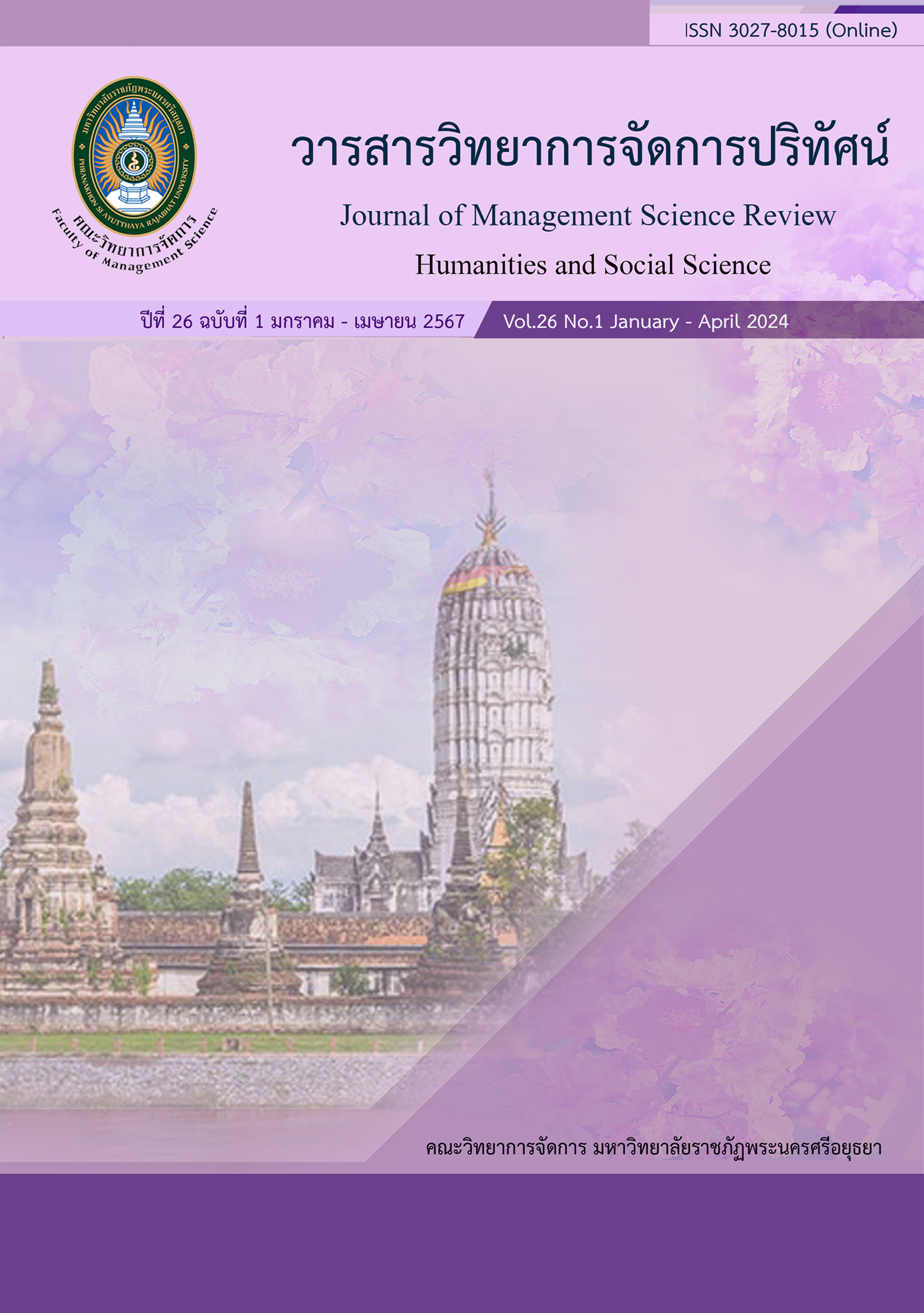การพัฒนากลุ่มอาชีพแบบมีส่วนร่วมสู่กลุ่มอาชีพผลิตภัณฑ์น้ำพริกชุมชน ตำบลท่าเจ้าสนุก อำเภอท่าเรือ จังหวัดพระนครศรีอยุธยา
คำสำคัญ:
การพัฒนากลุ่มอาชีพ, แบบมีส่วนร่วม, ผลิตภัณฑ์น้ำพริกชุมชนบทคัดย่อ
งานวิจัยนี้มีวัตถุประสงค์เพื่อ 1) ศึกษาบริบทของกลุ่มอาชีพแบบมีส่วนร่วมสู่กลุ่มอาชีพผลิตภัณฑ์น้ำพริกชุมชน 2) วิเคราะห์สภาพแวดล้อมของกลุ่มอาชีพแบบมีส่วนร่วมสู่กลุ่มอาชีพผลิตภัณฑ์น้ำพริกชุมชน 3) พัฒนาโมเดลธุรกิจด้วยเครื่องมือผ้าใบโมเดลธุรกิจ (Business Model Canvas: BMC) กลุ่มอาชีพแบบมีส่วนร่วมสู่กลุ่มอาชีพผลิตภัณฑ์น้ำพริกชุมชน 4) ศึกษาแนวทางในการพัฒนากลุ่มอาชีพแบบมีส่วนร่วมสู่กลุ่มอาชีพผลิตภัณฑ์น้ำพริกชุมชน ซึ่งเป็นการวิจัยเชิงคุณภาพ มีผู้ให้ข้อมูลหลัก คือ สมาชิกกลุ่มอาชีพผลิตภัณฑ์น้ำพริก ชุมชนตำบลท่าเจ้าสนุก อำเภอท่าเรือ จังหวัดพระนครศรีอยุธยา จำนวน 10 คน ได้แก่ ผู้นำกลุ่มอาชีพจำนวน 3 คน และสมาชิกในกลุ่มจำนวน 7 คน เครื่องมือที่ใช้ คือ การวิเคราะห์สภาพแวดล้อมทางธุรกิจด้วย SWOT Analysis และการพัฒนาธุรกิจด้วย BMC
ผลการวิเคราะห์สภาพแวดล้อมของกลุ่มอาชีพ พบว่า จุดแข็ง คือ สมาชิกในครัวเรือนมีคุณภาพชีวิตด้านจิตใจที่เข้มแข็ง มีความสุขในการดำรงชีวิต มีการแบ่งหน้าที่การทำงานอย่างชัดเจน จุดอ่อน คือ ขาดสภาพคล่องทางด้านการเงิน และขาดประสบการณ์ในการผลิตน้ำพริก โอกาส คือ มีหน่วยงานภาครัฐเข้ามาสนับสนุนอบรมให้ความรู้ อุปสรรคของกลุ่ม คือ เกิดสถานการณ์โควิด ทำให้กลุ่มไม่สามารถรวมตัวกันได้อย่างต่อเนื่อง ในส่วนของการพัฒนาโมเดลธุรกิจด้วย BMC พบว่า กลุ่มลูกค้า ได้แก่ ชาวบ้านในชุมชนและลูกค้าทั่วไป ซึ่งกลุ่มมีความใกล้ชิดกับคนในพื้นที่ รวมทั้งมีแหล่งตลาดในชุมชนและอาสาสมัครสาธารณสุขประจำหมู่บ้าน (อสม.) ใช้การกระจายสินค้า ทั้งออนไลน์และหน้าร้าน การผลิตและการเก็บถูกสุขอนามัย อุปกรณ์ในการผลิตได้มาตรฐาน มีการเลือกวัตถุดิบจากในพื้นที่ และออกแบบโลโก้ รวมทั้งคัดเลือกบรรจุภัณฑ์ได้อย่างเหมาะสม ทำให้เกิดการมีส่วนร่วมของกลุ่มอาชีพ และใช้ BMC ในการพัฒนาผลิตภัณฑ์น้ำพริก รวมทั้งทราบแนวทางในการพัฒนากลุ่มอาชีพแบบมีส่วนร่วม
เอกสารอ้างอิง
Bryman, A. (1986). Leadership and Organization. London: Routedge & Kegan Pahl.
Chambers, R., Pacey, A., and Thrupp, L. A. (1979). Farmer First: Farmer Innovation and agricultural Research. North Yorkshire: Short Run Press.
Cohen, J. M., Normal, T. & Uphoff, N. T. (1977). Rural development Participation: Concept and measures for project design implementation and evaluation. New York: The Rural Development Committee Center for international Studies.
Cohen, J. M., & Uphoff, N. T. (1981). Rural Development Participation: Concept and Measures for Project Design Implementation and Evaluation: Rural Development Committee.Center for international Studies. New York: Cornell University Press.
Fornaroff, A. (1980). Community involvement in Health System for Primary Health Care. Geneva: World Health Organization.
Haq, A. I., & Singgih, M. L. (2019). Business Strategy of Chemical Company Using SWOT and Business Model Canvas Approach. IPTEK Journal of Proceedings Series, (5), 34-42.
Nuphan, W. (2016). People's participation in village development according to the philosophy of Sufficiency Economy. Ban Tok Pok-Talung, Village No. 6, Wang Sapparos Subdistrict, Khlung District, Chanthaburi Province. [Master’s thesis]. Burapha University.
Sparviero, S. (2019). The Case for a Socially Oriented Business Model Canvas: The Social Enterprise Model Canvas. Journal of social entrepreneurship, 10(2), 232-251. https://doi.org/10.1080/19420676.2018.1541011
Toro- Jarrín, M. A., Ponce-Jaramillo, I. E., & Güemes-Castorena, D. (2016). Methodology for the of building process integration of Business Model Canvas and Technological Roadmap. Technological Forecasting & Social Change, 110, 213-225. http://dx.doi.org/10.1016/j.techfore.2016.01.009
Türko, E. S. (2016). Business Plan Vs Business Model Canvas in Entrepreneurship Trainings: A Comparison of Students' Perceptions. Asian Social Science, 12(10), 55-62. doi:10.5539/ass.v12n10p55
Yulia, y., Bahtera, N.I, Evahelda, E., Hayati, L., & Bahtera, N. T. (2020). Business development strategy using business model canvas approach.
Jurnal Muara Ilmu Ekonomi dan Bisnis, 4(1), 106-115. https://doi.org/10.24912/jmieb.v4i1.7563





